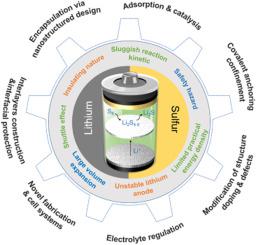Nano Energy ( IF 17.6 ) Pub Date : 2021-01-10 , DOI: 10.1016/j.nanoen.2021.105761 Wenjing Deng , Jason Phung , Ge Li , Xiaolei Wang

|
Lithium-sulfur batteries (LSBs) have been of paramount interest due to their high specific energy, environmental benignity, and low-cost production as a promising candidate among the next generation of rechargeable batteries. Even they represent one of the most mature battery systems, the high discharging capacity and stable long cycling performance cannot be fully realized, especially under practical conditions, which hamper their entrance to the energy storage market in the near future. Solutions to unsolved issues that arise during the complex and multiphase conversion-type chemistry involved in LSBs are still being researched, including irreversible relocation of polysulfides, slow reaction kinetics, and low reliability of lithium anode. Achieving a scientific understanding of the current challenges toward the individual components in cells and the existing status of research strategies is vitally important to the development of LSBs. In this critical review, we attempt to summarize our current comprehension in this field, analyze and classify possible strategies to address the main concerns in the research on LSBs, and introduce design pathways for the further improvement of LSBs toward practical applications. Advanced methodology toward the synthesis of desirable host materials of the electrode with encapsulation effect via nanostructured design; the tailorable adsorption and catalysis property; chemical confinements function by covalent linking; modification of electronic structure, heteroatom doping, and defects are overviewed and highlighted. Methods for regulating salt anions, solvents, auxiliary additives in electrolytes, and the constructions of interlayers toward deployable separator and anode enabling interfacial protection; the establishment of novel electrode fabrication and functional batteries assembly systems technologies are discussed for the further development of viable LSBs. The strategies and perspectives outlined in this review will provide further research directions and help to achieve the aim of exploring high-performance LSBs technology with high energy density and long cycling stability.
中文翻译:

通过合理的设计和工程策略实现高性能锂硫电池
锂硫电池(LSB)备受关注,因为它们具有较高的比能,环境友好性以及低成本生产,是下一代可充电电池中有希望的候选者。即使它们代表了最成熟的电池系统之一,也无法充分实现高放电容量和稳定的长循环性能,特别是在实际条件下,这阻碍了它们在不久的将来进入储能市场。LSB涉及的复杂和多相转化型化学过程中出现的未解决问题的解决方案仍在研究中,包括多硫化物的不可逆迁移,反应动力学慢和锂阳极可靠性低。对LSB的发展至关重要的是,对当前对细胞中单个成分的挑战和研究策略的现状有科学的了解。在这篇重要的评论中,我们试图总结我们在该领域的当前理解,分析和分类可能的策略,以解决LSB研究中的主要问题,并为进一步改进LSB走向实际应用引入设计途径。通过纳米结构设计合成具有封装效果的电极的理想主体材料的先进方法;可定制的吸附和催化性能;化学限制功能通过共价键连接;概述并突出了电子结构的修改,杂原子掺杂和缺陷。调节盐阴离子,溶剂,电解质中的辅助添加剂以及朝向可展开的隔板和阳极的中间层构造的方法,以实现界面保护;讨论了新型电极制造和功能电池组装系统技术的建立,以进一步发展可行的LSB。本文概述的策略和观点将提供进一步的研究方向,并有助于实现探索具有高能量密度和长循环稳定性的高性能LSBs技术的目的。讨论了新型电极制造和功能电池组装系统技术的建立,以进一步发展可行的LSB。本文概述的策略和观点将提供进一步的研究方向,并有助于实现探索具有高能量密度和长循环稳定性的高性能LSBs技术的目的。讨论了新型电极制造和功能电池组装系统技术的建立,以进一步发展可行的LSB。本文概述的策略和观点将提供进一步的研究方向,并有助于实现探索具有高能量密度和长循环稳定性的高性能LSBs技术的目的。



























 京公网安备 11010802027423号
京公网安备 11010802027423号